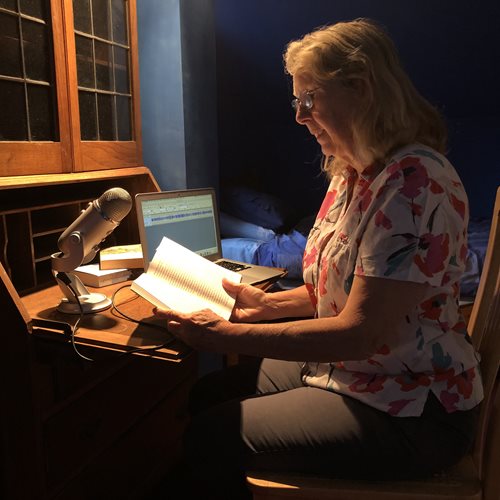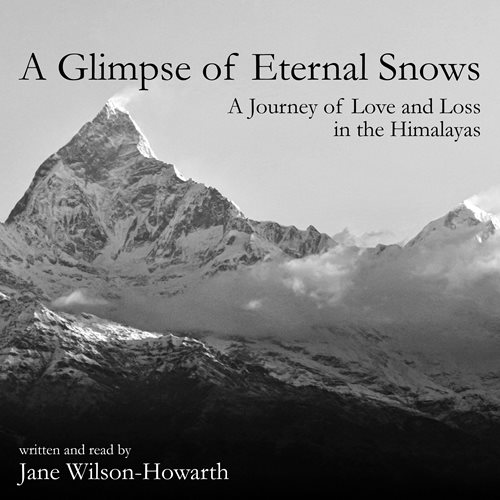It was an idea I’d been incubating for yonks, ever since Shaista Tayabali (@lupusinflight) suggested it when I spoke to her reading group. Initially I was too busy and distracted to get down to it, but evenutally I began having no idea how long it would take. My experience of reading out loud in writing groups meant I knew that I could narrate 1000 words easily in ten minutes, so although my memoir is quite a tome at 374 pages and little under 130,000 words, it was doable. It couldn’t take much more than 22 hours, so recording it wouldn’t take much longer than a week or so.
I thought of renting a studio and even employing someone to help but finally plugged in a fancy microphone I’d bought my son for one of his projects and started experimenting. The sound quality with the external microphone (appropriately for a book set in Nepal, called a Yeti) and my Mac seemed pretty good, and I started looking for advice on software. I played around with Garage Band as it was already on my Mac but then lots of authors seemed to favour Audacity and I ended up plumping for that.
And so in March, just as the pandemic was hotting up in Nepal, and in the UK too, I began recording
A Glimpse of Eternal Snows. I was in luck. Kathmandu is a noisy city and our apartment is big and echoey so planes flying over, revving trucks and squealing motorbikes would have been hard to exclude. But then lockdown happened in Nepal – it was at about the same time as in the UK – and air and vehicular traffic pretty much ceased. People fled the capital so that even the sounds of mothers shrieking at children, kids crying and pop music were less. It was only the sound of street dog fights that seemed to get worse, as no-one was feeding them any more.
I stuttered and stammered through some chapters, following the advice not to stop on making a mistake but to plough on and correct and edit later.
There was a lot to learn. I didn’t know about voice fatigue, or that the voice sounds different at different times of the day, and if recording was done in different rooms. Initially I thought that Kathmandu’s background sounds would add to the authenticity but they were never the right sounds.
On the page, a book or kindle reader is guided through dialogue with speech marks and line breaks so that it isn’t always necessary for an author to write, he said, she said on every line. The spoken word lacks these clues. It also turns out that it is better to have ‘He / She said’ at the beginning of a piece of dialogue rather than at the end so the listener knows who is speaking. Furthermore on reviewing the reading, although it is technically possible to move a phrase from the end of the speech to the beginning, the intonation is wrong, and it sounds out of place and confusing. Editing is different in this medium.
I worked steadily and felt pleased if I could record a whole chapter and edit it in a day and a half. I gritted my teeth and resisted editing the original text except where updates were needed. Recording consumed all of March, April (when we evacuated to the UK), May and some of June and July. I had already decided to add various bird calls to begin and end each chapter. Some are Nepali birds, some are English, depending upon where the action takes place.
 |
| Me and my yeti (microphone) - photo by Simon Howarth |
By this stage I’d learned a little about the enormously complex software package that is Audacity. I was ready to submit. There were problems and feedback increased my knowledge of yet more technical terms but I was able to upload 34 chapters (I wrote a short new one to bring the book bang up to date) to the Audible platform plus the five-minute sampler, and the opening and closing credits.
Their quality control processes were somewhat over-loaded – the world and his dog were recording their memoirs, it seemed – but 29 working days later I received an email pointing out all the problems I needed to fix before my files were acceptable.
There was such a long list that for some weeks I couldn’t bear to even work out what was required. As is often the way though, the list didn’t take as long to fix as I was expecting and I resubmitted and in early August. By September there was another (shorter) list to fix and another (even shorter one in November, which mostly meant deleting one or two seconds of silence at the beginnings and ends of all 37 files.
November came and went and I waited and waited for Audible to sort a discrepancy between the actual title of my book and the title Amazon thinks it goes by. Finally the techies returned to work after Thanksgiving and my memoir was launched on 18th of December.
The whole project took longer that I expected but it has been a labour of love.
A Glimpse of Eternal Snows is book that is written from my heart so I’m sure listeners will enjoy it, as long as no-one is too appalled by my attempts at Celtic accents. Here's the link to Audible
audiobook
There are another couple of blogs about the process of recording here:
A New Incarnation
 |
Cover of the new audiobook designed by Sebastian Howarth
from a photo of Machhapuchare by Jane |